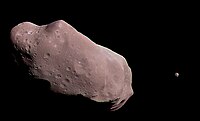
Photo from wikipedia
Abstract Assessments of the risk posed by asteroid impacts depend implicitly upon estimates of how frequently asteroids of different sizes and properties are expected to strike Earth. These impact rates… Click to show full abstract
Abstract Assessments of the risk posed by asteroid impacts depend implicitly upon estimates of how frequently asteroids of different sizes and properties are expected to strike Earth. These impact rates are generally based upon populations of near-Earth objects as a function of absolute magnitude, which are then translated to equivalent size frequencies by assuming an average albedo. However, this simplified approach neglects the broad distribution of sizes and properties among objects of a given absolute magnitude. In this study, we use a probabilistic asteroid impact risk model to more rigorously investigate the effects of asteroid property distributions on estimated impact rates as a function of diameter, energy, mass, and blast damage radius. We also use impact damage modeling results to compare the effects of the new distribution-based results on expected casualty rates for two sample risk assessment cases. The current study focuses on mid-sized objects with diameters of 20–300 m, which could cause substantial local ground damage but are unlikely to produce larger-scale regional or global effects. Particular emphasis is placed on sizes similar to the 1908 Tunguska event, which provides a unique source of evidence for such impacts and is often used as a reference point for damage potential and impact rates in the literature. Results demonstrate that accounting for realistic distributions of asteroid properties can significantly reduce expected impact intervals for these size ranges compared to estimates based on mean albedo, density, and velocity assumptions. These lower impact intervals, in turn, result in higher expected casualty estimates in impact risk assessment applications.
Journal Title: Icarus
Year Published: 2019
Link to full text (if available)
Share on Social Media: Sign Up to like & get
recommendations!